- Home
- Carl Sagan
Shadows of Forgotten Ancestors
Shadows of Forgotten Ancestors Read online
Shadows of Forgotten Ancestors was selected by School Library Journal as one of nine “best books of the year” out of 40,000 titles: “The enchanting writing style captivates … a clarity that will hold the interest of the most science-phobic reader.”
“A funhouse maze of biology, psychology, evolution, fact, theory, probability, possibility, and awe … Warning Those who regard the human condition as the inviolable perch at the top of the evolutionary heap, the gold watch at the end of the great chain of being, will find much in Shadows that disturbs.”
—Miami Herald
“In this book Carl Sagan and Ann Druyan illuminate some of the most daunting questions of our time, and any time, sometimes explaining them straight out, sometimes challenging the reader to contemplate the truths we hold dear. Shadows is one of those rare books that should be required reading.”
—New Orleans Times-Picayune
“Jam-packed with fascinating anecdotes, a playful wit and humor, a wide-ranging command of relevant scientific data, and (a warning to readers who are easily scandalized), an ‘indecorous explicitness on matters sexual.’ ”
—Nashville Banner
“Superb.”
—Tom Peters
Chicago Tribune
“Their latest literary wonder.”
—New York Times Syndicate
“It has been a long time since I came across a nonfiction book as compelling as this one. At times I found myself impatiently turning pages, as if I were reading a murder mystery and couldn’t wait to discover the ending.”
—Corpus Christi Caller-Times
“An eloquent attempt to place the human species in context … They use the same compelling style that made Cosmos such an international success.… It is a big story. Indeed, it is the biggest story.”
—Worcester (Massachusetts) Telegram
“A coherent, moving story … Philosophical, poetic, even witty, [with] a sense of almost religious awe.”
—Book Page
“Excellent … An important book that deserves to be widely read and discussed.”
—Monroe Strickberger
Author of the textbook Evolution,
writing in the San Francisco Examiner-Chronicle
“Formidably intelligent and well-informed.”
—Chicago Sun Times
“Hauntingly appealing. Carl Sagan is probably the best literary stylist American science has produced since Loren Eiseley and Lewis Thomas.”
—The Observer (London)
“Informative, enlightening, and refreshingly unacademic.”
—Atlanta Journal & Constitution
“It is easy to hear his familiar voice guiding the reader through time and the early rumblings of the universe through the development of DNA, evolution, and the rise of modern primates.”
—Gannett News Service
“Sagan’s contribution to increasing public understanding of science and making provocative connections between different areas are at the highest level of benefit to our society.”
—John Bahcall
Institute for Advanced Study Princeton, NJ
“It has sex. It has humor. It has drama. It’s what people go to the movies for.”
—Steve Knight
KIEV-AM, Los Angeles
“They go boldly where many scientists have feared to tread … And what a journey it is!”
—Phoenix (Arizona) Gazette
“Eloquent … Visionary … Powerfully imagined.”
—Booklist
“Engaging … Lyrical … Stunning.”
—Publishers Weekly
ALSO BY CARL SAGAN AND ANN DRUYAN
Comet
Murmurs of Earth (with others)
SOME OTHER BOOKS BY CARL SAGAN
Intelligent Life in the Universe (with I. S. Shklovskii)
The Cosmic Connection
The Dragons of Eden
Brocas Brain
Cosmos
Contact
A Path Where No Man Thought (with Richard Turco)
ALSO BY ANN DRUYAN
A Famous Broken Heart
A carving from the Sepik River, central highlands of Papua New Guinea.
A Ballantine Book
Published by The Random House Publishing Group
Copyright © 1992 by Carl Sagan and Ann Druyan
All rights reserved under International and Pan-American Copyright Conventions Published in the United States by Ballantine Books, an imprint of The Random House Publishing Group, a division of Random House, Inc, New York, and simultaneously in Canada by Random House of Canada Limited, Toronto
This edition published by arrangement with Random House, Inc
Permissions acknowledgments for previously published
material can be found on this page
Library of Congress Catalog Card Number: 93-90012
Ballantine and colophon are registered trademarks of Random House, Inc
www.ballantinebooks.com
eISBN: 978-0-307-80103-6
v3.1
TO
LESTER GRINSPOON,
WHOSE EXAMPLE REASSURES US
THAT OUR SPECIES
MAY HAVE
WHAT IT TAKES
Thus she spoke; and I longed
to embrace my dead mother’s ghost.
Thrice I tried to clasp her
image, and thrice it slipped
through my hands, like a
shadow, like a dream.
HOMER
The Odyssey
Contents
Cover
Other Books by This Author
Title Page
Copyright
Dedication
Epigraph
Introduction
Prologue: The Orphan’s File
1 On Earth as It Is in Heaven
2 Snowflakes Fallen on the Hearth
3 “What Makest Thou?”
4 A Gospel of Dirt
5 Life Is Just a Three-Letter Word
6 Us and Them
7 When Fire Was New
8 Sex and Death
9 What Thin Partitions …
10 The Next-to-Last Remedy
11 Dominance and Submission
12 The Rape of Caenis
13 The Ocean of Becoming
14 Gangland
15 Mortifying Reflections
16 Lives of the Apes
17 Admonishing the Conqueror
18 The Archimedes of the Macaques
19 What Is Human?
20 The Animal Within
21 Shadows of Forgotten Ancestors
Epilogue
Notes
Permissions Acknowledgments
The Authors
Introduction
We were very lucky. We were raised by parents who took seriously their responsibility to be strong links in the chain of generations. The search that informs this book may be said to have begun in childhood, when we were given unconditional love and protection in the face of real adversity. It’s an ancient practice of the mammals. It was never easy. In modern human society, it’s even harder. There are so many dangers now, so many of them unprecedented.
The book itself began in the early 1980’s when the rivalry between the United States and the Soviet Union was making a potentially fateful intersection with 60,000 nuclear weapons that had been accumulated for reasons of deterrence, coercion, pride, and fear. Each nation praised itself and vilified its adversaries, who were sometimes portrayed as less than human. The United States spent ten trillion dollars on the Cold War—enough to buy everything in the country except the land. Meanwhile, the infrastructure was collapsing, the environment was deteriorating, the democratic process was being subverted, injustice festered, and the nation was converted from the leading lender to the leading debtor on the planet. How did we get into this mess? we asked ourselves. How can we get out? Can we get out?
So we embarked on a study of the political and emotional roots of the nuclear arms race—which led us back to World War II, which of course had its origins in World War I, which was a consequence of the rise of the nation-state, which traces straight back to the very beginnings of civilization, which was a by-product of the invention of agriculture and the domestication of animals, which crystallized out of a very long period in which we humans were hunters and foragers. There was no sharp division along the way, no point at which we could say: Here are the roots of our predicament. Before we knew it, we were looking to the first humans and their predecessors. Events of remote ages, long before humans came to be, are critical, we concluded, for an understanding of the trap that our species seems to be setting for itself.
We resolved to look inside ourselves, to retrace as many of the important twists and turns of the evolution of our species as we were able. We made a compact with each other not to turn back, no matter where the search might lead. We had learned much from each other over the years, but our own politics are not identical. There was a chance that one or both of us might have to give up some of those beliefs we considered self-defining. But if we were successful, even in part, perhaps we could understand much more than just nationalism, the nuclear arms race, and the Cold War.
As we complete this book, the Cold War is over. But somehow we are not home free. New dangers edge their way onto center stage, and old familiar ones reassert themselves. We are confronted with a witches’ brew of ethnic violence, resurgent nationalism, inept leaders, inadequ
ate education, dysfunctional families, environmental decay, species extinctions, burgeoning population, and increasing millions with nothing to lose. The need to understand how we got into this mess and how to get out seems more urgent than ever.
This book addresses the deep past, the most formative steps in our origins. Later, we will gather up the threads laid down here. We have been led to the writings of those who preceded us in this search, to distant epochs and other worlds and across a multitude of disciplines. We tried to keep in mind the physicist Niels Bohr’s aphorism, “Clarity through breadth.” The breadth required can be a little daunting, though. Humans have erected high walls separating the branches of knowledge essential to this quest—the various sciences, politics, religions, ethics. We have searched for low doors in the walls, or sometimes tried to vault over or burrow under. We feel a need to apologize for our limitations. We are well aware of the inadequacies of our knowledge and of our discernment. And yet such a search has no chance of succeeding unless those walls are breached. We hope that where we have failed, others will be inspired (or provoked) to do better.
What we are about to say draws on the findings of many sciences. We urge the reader to bear in mind the imperfection of our current knowledge. Science is never finished. It proceeds by successive approximations, edging closer and closer to a complete and accurate understanding of Nature, but it is never fully there. From the fact that so many major discoveries have been made in the last century—even in the last decade—it is clear that we still have far to go. Science is always subject to debate, correction, refinement, agonizing reappraisals, and revolutionary insights. Nevertheless, there now seems to be enough known to reconstruct some of the key steps that led to us and helped to make us who we are.
On our journey we encountered many who were generous with their time, expertise, wisdom, and encouragement, many who carefully and critically read all or part of the manuscript. As a result, deficiencies were removed, and errors of fact or interpretation corrected. We particularly thank Diane Ackerman; Christopher Chyba, Ames Research Center, NASA; Jonathan Cott; James F. Crow, Department of Genetics, University of Wisconsin, Madison; Richard Dawkins, Department of Zoology, Oxford University; Irven de Vore, Department of Anthropology, Harvard University; Frans B. M. de Waal, Department of Psychology, Emory University, and Yerkes Primate Research Center; James M. Dabbs, Jr., Department of Psychology, Georgia State University; Stephen Emlen, Section of Neurobiology and Behavior, Cornell University; Morris Goodman, Department of Anatomy and Cell Biology, Wayne State University School of Medicine; Stephen Jay Gould, Museum of Comparative Zoology, Harvard University; James L. Gould and Carol Grant Gould, Department of Biology, Princeton University; Lester Grinspoon, Department of Psychiatry, Harvard Medical School; Howard E. Gruber, Department of Developmental Psychology, Columbia University, Jon Lomberg; Nancy Palmer, Shorenstein Barone Center on the Press and Politics, Kennedy School of Government, Harvard University; Lynda Obst; William Provine, Departments of Genetics and of the History of Science, Cornell University; Duane M. Rumbaugh and E. Sue Savage-Rumbaugh, Language Research Center, Georgia State University; Dorion, Jeremy, and Nicholas Sagan; J. William Schopf, Center for the Study of Evolution and the Origin of Life, University of California, Los Angeles; Morty Sills; Steven Soter, Smithsonian Institution; Jeremy Stone, Federation of American Scientists; and Paul West. Many scientists kindly sent us pre-publication copies of their work. C.S. also thanks his early teachers in the life sciences, H. J. Muller, Sewall Wright, and Joshua Lederberg. Of course none of these people are responsible for any remaining errors.
We are deeply grateful to those who ushered this work through its various drafts. For excellence in library research, transcription, file keeping, and much else we owe a special debt of gratitude to A.D.’s assistant, Karenn Gobrecht, and to C.S.’s long-time Administrative Assistant at Cornell, Eleanor York. We also thank Nancy Birn Struckman, Dolores Higareda, Michelle Lane, Loren Mooney, Graham Parks, Deborah Pearlstein, and John P. Wolff. The superb facilities of the Cornell University library system were a critical resource in the writing of this book. We also could not have written it without the help of Maria Farge, Julia Ford Diamond, Lisbeth Collacchi, Mamie Jones, and Leona Cummings.
We are indebted to Scott Meredith and Jack Scovil of the Scott Meredith Literary Agency for unstinting encouragement and support. We are happy that Shadows has come to fruition during Ann Godoff’s tenure as our editor; and also thank Harry Evans, Joni Evans, Nancy Inglis, Jim Lambert, Carol Schneider, and Sam Vaughan at Random House.
Walter Anderson, the editor-in-chief of Parade magazine, has made it possible for us to present our ideas to the broadest possible audience. Working with him and Senior Editor David Currier has been an unalloyed pleasure.
This book is written for a wide readership. For clarity, we have sometimes stressed the same point more than once, or in more than one context. We have tried to indicate qualifications and exceptions. The pronoun “we” is used sometimes to mean the authors of this book, but usually to mean the human species; the context should make clear which is meant. For those who wish to dig deeper, references to other works, popular and technical—keyed to superscripts in the text—are in the back of the book. Also to be found there are additional comments, notes, and clarifications. Although the two works have little else in common, the haunting 1964 film by Sergei Parajanov gave us our title.
As for essential inspiration and a heightened sense of urgency, it was during the years of preparation of this book that we became the parents of Alexandra Rachel and Samuel Democritus—beloved namesakes of unforgettable ancestors.
CARL SAGAN
ANN DRUYAN
June 1, 1992
Ithaca, N.Y.
Prologue
THE
ORPHAN’S
FILE
Having seen a small part of life, swift to die,
men rise and fly away like smoke, persuaded
only of what each has met with … Who then
claims to find the whole?
EMPEDOCLES
On Nature1
Who are we? The answer to this question is not
only one of the tasks, but the task of science.
ERWIN SCHRÖDINGER
Science and Humanism2
The immense, overpowering blackness is relieved here and there by a faint point of light—which, upon closer approach, is revealed to be a mighty sun, blazing with thermonuclear fire and warming a small surrounding volume of space. The Universe is, almost entirely, black emptiness, and yet the number of suns is staggering. The neighborhoods immediately encompassing these suns represent an insignificant fraction of the vastness of the Cosmos, but many, perhaps most, of those cheerful, bright, clement circumstellar regions are occupied by worlds. In the Milky Way galaxy alone there may be a hundred billion of them—neither too close by, nor too distant from, the local sun, around which they orbit in silent gravitational homage.
This is a story about one such world, perhaps not very different from many others—a story, especially, about the beings that evolved upon it, and one kind in particular.
Just to be alive billions of years after the origin of life, a being must be tough, resourceful, and lucky: There have been so many hazards along the way. Lifeforms endure by being patient, say, or ravenous, or solitary and camouflaged, or profligate with offspring, or fearsome hunters, or able to fly away to safety, or sleek swimmers, or burrowers, or sprayers of noxious, disorienting liquids, or masters at infiltrating into the very genetic material of other, unsuspecting, beings; or by accidentally being elsewhere when the predators stalk or the river is poisoned or the food supply dwindles. The creatures with which we are particularly concerned were, not so long ago, gregarious to a fault, noisy, quarrelsome, arboreal, bossy, sexy, clever, tool-using, with prolonged childhoods and tender regard for their young. One thing led to another, and in a twinkling their descendants had multiplied all over the planet, killed off all their rivals, devised world-transforming technologies, and posed a mortal danger to themselves and the many other beings with whom they shared their small home. At the same time, they set off to visit the planets and the stars.

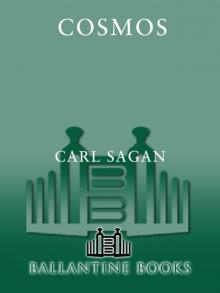 Cosmos
Cosmos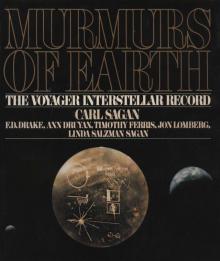 Murmurs of Earth
Murmurs of Earth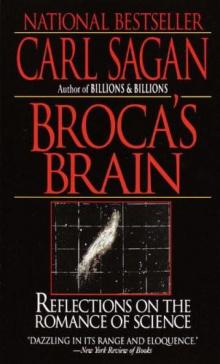 Broca's Brain
Broca's Brain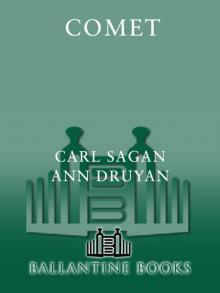 Comet
Comet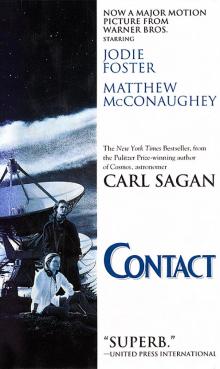 Contact
Contact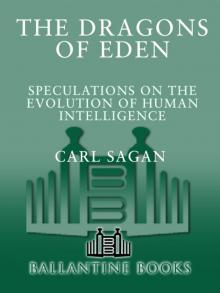 Dragons of Eden
Dragons of Eden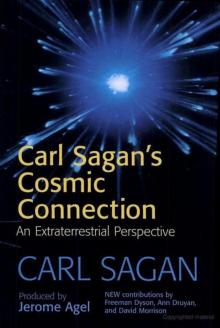 Cosmic Connection
Cosmic Connection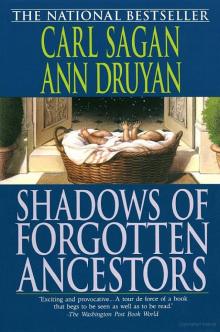 Shadows of Forgotten Ancestors
Shadows of Forgotten Ancestors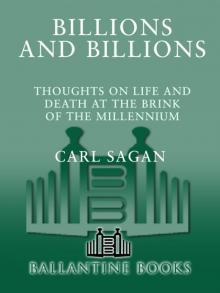 Billions & Billions
Billions & Billions Comet, Revised
Comet, Revised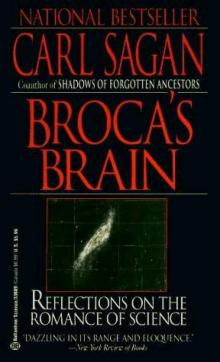 Broca's Brain: The Romance of Science
Broca's Brain: The Romance of Science The Varieties of Scientific Experience: A Personal View of the Search for God
The Varieties of Scientific Experience: A Personal View of the Search for God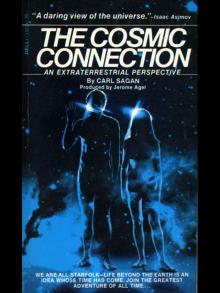 The Cosmic Connection
The Cosmic Connection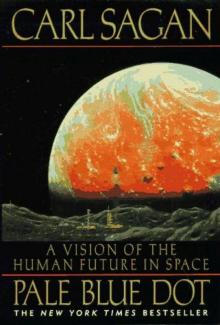 Pale Blue Dot: A Vision of the Human Future in Space
Pale Blue Dot: A Vision of the Human Future in Space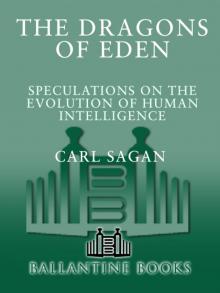 The Dragons of Eden
The Dragons of Eden